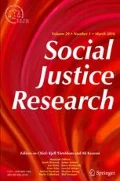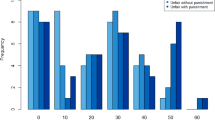Abstract
Two studies tested the hypothesis that organizational decision makers attempt to counterbalance contribution-based distributions of financial/material rewards (a “merit” system that creates monetary inequality) with need- and equality-based allocations of socioemotional rewards, in effect allocating “roses” in lieu of more “bread”. Experiment 1 had a two-factor design (Reward Type × Magnitude of Income Inequality); 67 subjects were given a managerial in-basket exercise in which they expressed their preferences for a variety of distributive justice rules for seven different types of rewards. Experiment 2 (N=39) had the same design, with a stronger manipulation of magnitude of inequality. Results of the two experiments were consistent with the counterbalancing hypothesis, irrespective of magnitude of income inequality; financially related rewards (e.g., profit sharing, office space, company cars) were distributed with more emphasis on contribution rules (i.e., performance, status), while more socioemotional rewards (e.g., help for an employee's spouse, friendliness) were allocated with more emphasis on equality among individuals, equality across groups, and personal need.
Similar content being viewed by others
References
Adams, J. S. (1965). Inequity in social exchange. In Berkowitz, L. (ed.),Advances in Experimental Social Psychology, Vol. 2, Academic Press, New York, pp. 267–299.
Alves, W. H., and Rossi, P. H. (1978). Who should get what? Fairness of judgments of the distribution of earnings.Am. J. Sociol. 83: 541–564.
Assmar, E. M. (1989). Justica distributiva: Variaveis de personalidade e variaveis situacionais.Psicol. Teoria Pesquisa 5: 99–109.
Austin, W., and McGinn, N. C. (1977). Sex differences in choice of distribution rules.J. Pers. 45: 379–394.
Belcher, D. W. (1974).Compensation Administration, Prentice-Hall, Englewood Cliffs, NJ.
Boulding, K. E. (1962). Social justice in social dynamics. In Brandt, R. B. (ed.),Social Justice, Prentice-Hall, Englewood Cliffs, NJ, pp. 73–92.
Brewer, M. B., Dull, V., and Lui, L. (1981). Perceptions of the elderly: Stereotypes as prototypes.J. Personality Soc. Psychol. 41: 656–670.
Brickman, P., Folger, R., Goode, E., and Schul, Y. (1981). Microjustice and macrojustice. In Lerner, M. J., and Lerner, S. C. (eds.),The Justice Motive in Social Behavior, Plenum Press, New York, pp. 173–202.
Brockner, J., O'Malley, M. N., Hite, T., and Davies, D. K. (1987). Reward allocation and self-esteem: The roles of modeling and equity restoration.J. Pers. Soc. Psychol. 52: 844–850.
Brockner, J., Tyler, T. R., and Cooper-Schneider, R. (1992). The influence of prior commitment to an institution on reactions to perceived unfairness: The higher they are, the harder they fall.Admin. Sci. Quart. 37: 241–261.
Cohen, R. L. (1982). Perceiving justice: An attributional perspective. In Greenberg, J., and Cohen, R. L. (eds.),Equity and Justice in Social Behavior, Academic Press, New York, pp. 119–160.
Cowherd, D. M., and Levine, D. I. (1992). Product quality and pay equity between lower-level employees and top management: An investigation of distributive justice theory.Admin. Sci. Quart. 37: 302–320.
Crosby, F. J. (1982).Relative Deprivation and Working Women, Oxford University Press, New York.
Curtis, R. F. (1986). Household and family in theory on inequality.Am. Sociol. Rev. 51: 168–183.
Deutsch, M. (1975). Equity, equality, and need: What determines which value will be used as the basis of distributive justice?J. Soc. Issues 31: 137–150.
Deutsch, M. (1985).Distributive Justice: A Social-Psychological Perspective, Yale University Press, New Haven, CT.
Foa, U. G., and Foa, E. B. (1974).Societal Structures of the Mind, C C Thomas, Springfield, IL.
Foa, U. G., and Stein, G. (1980). Rules of distributive justice: Institution and resource influences.Acad. Psychol. Bull. 2: 89–94.
Greenberg, J. (1980). Status-induced inequity as a cheap but temporary motivator. Unpublished manuscript, Tulane University, New Orleans.
Greenberg, J., and Orstein, S. (1983). High status job title as compensation for underpayment: A test of equity theory.J. Appl. Psychol. 68: 285–297.
Headey, B. (1991). Distributive justice and occupational incomes: Perceptions of justice determine perceptions of fact.Br. J. Sociol. 42: 581–596.
Homans, G. C. (1974).Social Behavior: Its Elementary Forms, Rev. ed. Harcourt Brace Jovanovich, New York.
Kabanoff, B. (1991). Equity, equality, power, and conflict.Acad. Manage. Rev. 16: 416–441.
Kanter, R. M. (1977).Men and Women of the corporation, Basic Books, New York.
Lane, R. E. (1962).Political Ideology: Why the American Common Man Believes What He Does. Free Press of Glencoe, New York.
Lawler, E. E. (1971).Pay and Organizational Effectiveness: A Psychological View. McGraw-Hill, New York.
Leung, K., and Bond, M. H. (1984). The impact of cultural collectivism on reward allocation.J. Pers. Soc. Psychol. 47: 793–804.
Lissowski, G., Tyszka, T., and Okrasa, W. (1991). Principles of distributive justice: Experiments in Poland and America.J. Conflict Resolution 35: 98–119.
Martin, J. (1986a). When expectations and justice do not coincide: Blue Collar visions of a just world. In Bierhoff, H. W., Cohen, R. L., and Greenberg, J. (eds.),Justice in Social Relations, Plenum Press, New York, pp. 317–335.
Martin, J. (1986b). The tolerance of injustice. In Olson, J., Herman, C. P., and Zanna, M. P. (eds.),Relative Deprivation and Social Comparison: The Ontario Symposium, Vol. 4, Erlbaum, Hillsdale, NJ, pp. 217–242.
Martin, J., Feldman, M. S., Hatch, M. J., and Sitkin, S. B. (1983). The uniqueness paradox in organizational stories.Admin. Sci. Quart. 28: 438–453.
Meindl, J. R. (1989). Managing to be fair: An exploration of values, motives, and leadership.Admin. Sci. Quart. 34: 252–276.
Mowday, R. T. (1979). Equity theory predictions of behavior in organizations. In Steer, R. M., and Porter, L. W. (eds.),Motivation and Work Behavior 2nd ed., McGraw-Hill, New York, pp. 124–146.
Pfeffer, J., and Langton, N. (1988). Wage inequality and the organization of work: The case of academic departments.Admin. Sci. Quart. 33: 588–606.
Rusbult, C. E., Lowery, D., Hubbard, M. L., Maravankin, O. J., and Neises, M. (1988). Impact of employee mobility and employee performance on the allocation of rewards under conditions of constraint.J. Pers. Soc. Psychol. 54: 605–615.
Rusbult, C. E., Insko, C. A., Lin, Y. W., and Smith, W. J. (1990). Social motives underlying rational selective exploitation: The impact of instrumental versus social-emotional allocation orientation on the distribution of rewards in groups.J. Appl. Soc. Psychol. 20: 984–1025.
Schwinger, T. (1986). The need principle of distributive justice. In Bierhoff, H. W., Cohen, R. L., and Greenberg, J. (eds.),Justice in Social Relations, Plenum Press, New York, pp. 211–223.
Stouffer, S., Lumsdaine, A., Lumsdaine, M., Williams, R., Smith, M., Janis, I., Star, S., and Cottrell, L. (1949).The American Soldier, Princeton University Press, Princeton, NJ.
Tanaka, K. (1990). Multidimensional study on determinants of reward allocation behavior.Jap. J. Exp. Soc. Psychol. 30: 63–69.
Tornblom, K. Y., and Foa, U. G. (1983). Choice of a distribution principle: Crosscultural evidence on the effects of resources.Acta Sociol. 26: 161–163.
Tornblom, K. Y., and Jonsson, D. R. (1984).Subrules of the equality and contribution principles: Their perceived fairness in distribution and retribution (Report No. 10). University of Goteberg, Sweden.
Walster, E., Walster, W. G., and Berscheid, E. (1978).Equity: Theory and Research, Allyn and Bacon, Boston.
Walzer, M. (1983).Spheres of Justice: A Defense of Pluralism and Equality, Basic Books, New York.
Author information
Authors and Affiliations
Rights and permissions
About this article
Cite this article
Martin, J., Harder, J.W. Bread and roses: Justice and the distribution of financial and socioemotional rewards in organizations. Soc Just Res 7, 241–264 (1994). https://doi.org/10.1007/BF02334833
Issue Date:
DOI: https://doi.org/10.1007/BF02334833




